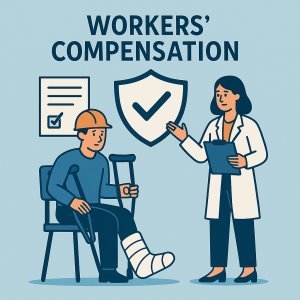
Security Guard Workers’ Comp vs. Disability Insurance: Complement or Overlap?
July 28, 2025Bundling General Liability and Workers’ Comp for Nursing Homes—Smart or Risky?
July 28, 2025In today’s rapidly evolving healthcare landscape, national senior care providers face a complex regulatory habitat, notably when it comes to managing workers’ compensation across multiple states. Ensuring multi-state workers’ comp compliance is not only critical for mitigating legal and financial risks but also essential for maintaining operational continuity and protecting the well-being of employees who deliver vital services. This article explores the key challenges and best practices for navigating workers’ compensation requirements in diverse jurisdictions, offering strategic insights to help senior care organizations achieve consistent compliance, optimize risk management, and uphold the highest standards of workforce protection nationwide.
Table of Contents
- Understanding State-specific Workers’ compensation Regulations for Senior Care Providers
- Key Compliance Challenges in Managing Multi-State Workers’ Compensation Programs
- Implementing Best Practices for Seamless Claims Management Across Jurisdictions
- Strategic Recommendations for Reducing Liability and Enhancing Compliance Efficiency
- Q&A
- To wrap It Up
Understanding State-Specific Workers’ Compensation Regulations for Senior Care Providers
Each state operates under a unique framework of workers’ compensation laws, making compliance a complex but essential priority for senior care providers operating across multiple jurisdictions. Understanding these differences not only ensures legal adherence but also protects the organization’s financial stability and reputation.Key regulatory variances include benefit structures, claim processes, coverage requirements, and employer reporting obligations. For example, while some states mandate coverage for all employees regardless of hours worked, others exempt part-time or seasonal workers. Navigating these nuances requires meticulous policy review and localized expertise to reduce risk and maintain consistent care standards.
To streamline regulatory compliance, senior care operators should consider implementing centralized systems that track state-specific mandates and automate key compliance tasks. Below is an overview of common differences in workers’ compensation provisions across selected states:
| State | Mandatory Coverage | Benefit Max Duration | Claim Notice Period |
|---|---|---|---|
| California | All employees | 104 weeks | 30 days |
| Texas | Optional for most private employers | Depends on policy | 30 days |
| New York | All employees | 400 weeks | 30 days |
| Florida | Employers with 4+ employees | 260 weeks | 30 days |
Understanding and integrating these jurisdictional specifics into corporate risk management and human resource workflows will enhance operational consistency and reduce the likelihood of costly penalties or litigation. Equipping compliance teams with comprehensive training and access to up-to-date resources ensures the organization remains agile in the face of evolving legislation and workforce challenges specific to the senior care sector.
- Regular regulatory audits tailored to each operational state
- Automated alerts for changing laws and reporting deadlines
- Localized claims management protocols to expedite resolution
- State-specific employee interaction strategies regarding rights and procedures
key Compliance Challenges in Managing Multi-State Workers’ Compensation Programs
Core challenges include:
- Keeping up with frequent legislative updates and state-specific amendments.
- Managing disparate premium calculation methods and classifications.
- Balancing centralized oversight with localized compliance demands.
- Implementing consistent workplace safety standards across different regulatory environments.
| Compliance Aspect | Common Variations | Impact |
|---|---|---|
| Claims Reporting | Time frames vary from 24 to 72 hours | Delays trigger fines and claim denials |
| Premium Payment | Monthly vs.Quarterly schedules | affects cash flow and risk management |
| Benefit Structures | Differences in wage replacement rates | Impacts budgeting and employee relations |
Implementing Best Practices for Seamless Claims Management Across Jurisdictions
Establishing a collaborative partnership between internal claims teams and external insurance adjusters ensures adherence to each state’s specific procedural timelines and benefit structures. To maintain compliance and optimize outcomes, focus on:
- Regular audits for claim accuracy and legal conformity
- Cross-jurisdictional knowlege sharing sessions
- Centralized reporting dashboards for executive oversight
- Employee education programs on local workers’ comp rights and responsibilities
| Jurisdiction | Maximum Benefit Duration | Filing Deadline | Key Compliance Focus |
|---|---|---|---|
| California | 104 weeks | 30 days | Timely reporting and permanent disability evaluation |
| Texas | Maximum 500 weeks | 15 days | Employer benefit notice and written acceptance |
| New York | 104 weeks | 10 days | Medical treatment authorization and return-to-work coordination |
Strategic Recommendations for Reducing Liability and Enhancing Compliance Efficiency
To mitigate risks effectively across multiple states, senior care providers should implement a centralized compliance framework that integrates real-time regulatory updates with payroll and HR systems.This proactive approach allows organizations to anticipate and address varying workers’ compensation requirements, reducing the likelihood of costly violations. Leveraging technology solutions such as compliance management software not only enhances accuracy in reporting but also streamlines documentation processes, ensuring ready access to evidence during audits or claims investigations.
Key strategic actions include:
- Conducting regular multi-state risk assessments to identify and prioritize exposure points.
- Establishing cross-functional compliance teams responsible for continuous policy review and training delivery.
- Implementing standardized incident reporting protocols tailored to each state’s legal nuances.
- Utilizing data analytics to track claim trends and optimize insurance premium allocations.
| Strategy | Benefit | Implementation Timeline |
|---|---|---|
| Centralized Compliance Software | Streamlined multi-state data management | 3-6 Months |
| Cross-Functional Training Programs | Consistent policy request | Ongoing |
| Risk Assessment Audits | Early detection of liability gaps | Quarterly |
Q&A
Q&A: Multi-state Workers’ Comp Compliance for National Senior Care Providers
Q1: What is workers’ compensation, and why is it important for senior care providers operating in multiple states?
A1: Workers’ compensation is a form of insurance that provides wage replacement and medical benefits to employees injured in the course of employment. For senior care providers working across multiple states, complying with workers’ compensation laws is crucial because each state has unique regulations and requirements. Proper compliance ensures financial protection, legal adherence, and supports workforce stability by addressing workplace injuries promptly and fairly.
Q2: What are the primary challenges national senior care organizations face in managing multi-state workers’ comp compliance?
A2: The main challenges include understanding and meeting differing state-specific policies, navigating various reporting requirements, managing multiple carriers and insurance policies, and ensuring seamless claims governance.additionally, variations in coverage thresholds, benefit structures, and regulatory updates require expert oversight to avoid penalties and reduce operational risk.
Q3: How do state-specific workers’ comp laws differ and impact national senior care providers?
A3: Differences may include mandatory coverage rules, classification codes for senior care roles, premium calculation methodologies, injury reporting timelines, and employee eligibility criteria. These variances impact cost management and administrative processes. For example, some states may exclude certain part-time workers, while others mandate coverage regardless of hours worked, influencing compliance strategies.
Q4: What strategies can senior care providers implement to streamline multi-state workers’ compensation compliance?
A4: Effective strategies include centralizing compliance oversight within a dedicated risk management team, leveraging technology platforms that aggregate and track state-specific requirements, engaging experienced legal and insurance advisors, conducting regular training for HR and operational staff, and maintaining strong relationships with insurers who understand multi-jurisdictional frameworks.
Q5: What are the potential consequences of non-compliance with workers’ comp laws in various states?
A5: Non-compliance can result in costly penalties, fines, and increased insurance premiums. It may also lead to legal action, stop-work orders, and reputational damage affecting patient trust and staff morale. Moreover, failure to provide adequate coverage can expose the organization to direct liability for workplace injuries, amplifying financial risks.
Q6: Can national senior care providers self-insure workers’ compensation claims across multiple states?
A6: Some providers may choose to self-insure if they have the financial capacity and meet state-specific eligibility requirements, which vary significantly. Self-insurance can offer cost savings and greater control over claims management but requires robust risk assessment and compliance measures. Each state’s regulatory body must approve self-insurance plans, and ongoing reporting and funding adequacy must be demonstrated.
Q7: How does proactive workers’ comp compliance benefit senior care organizations beyond regulatory adherence?
A7: Beyond legal compliance, proactive management of workers’ compensation helps reduce workplace injuries through risk mitigation programs, enhances employee safety culture, lowers turnover, and controls costs by minimizing claim frequency and severity. It also builds credibility with regulators and insurers, which can lead to more favorable policy terms and improved operational resilience.
Q8: What future trends should national senior care providers anticipate in multi-state workers’ compensation compliance?
A8: Providers should anticipate increasing regulatory complexity as states update laws to reflect changes in workforce demographics, telehealth practices, and emerging risks such as infectious diseases.There will likely be greater emphasis on data analytics for claims management, integration of digital compliance solutions, and evolving standards around gig and contract workers. Staying informed and agile will be essential to maintaining compliance and operational excellence.
This Q&A offers a foundational understanding tailored to senior care providers navigating the complexities of multi-state workers’ compensation compliance in a professional business context.
To Wrap It Up
In today’s increasingly interconnected senior care landscape, navigating multi-state workers’ compensation compliance is not just a regulatory necessity but a critical component of operational stability and risk management. National senior care providers must stay informed of varying state requirements, implement robust compliance strategies, and leverage technology to streamline processes. By prioritizing comprehensive workers’ comp compliance across all jurisdictions, organizations can protect their workforce, minimize legal exposure, and uphold the highest standards of care. Ultimately, a proactive and informed approach ensures sustainable growth and reinforces the trust placed in senior care providers across the nation.
“This content was generated with the assistance of artificial intelligence. While we strive for accuracy, AI-generated content may not always reflect the most current information or professional advice. Users are encouraged to independently verify critical information and, where appropriate, consult with qualified professionals, lawyers, state statutes and regulations & NCCI rules & manuals before making decisions based on this content.







